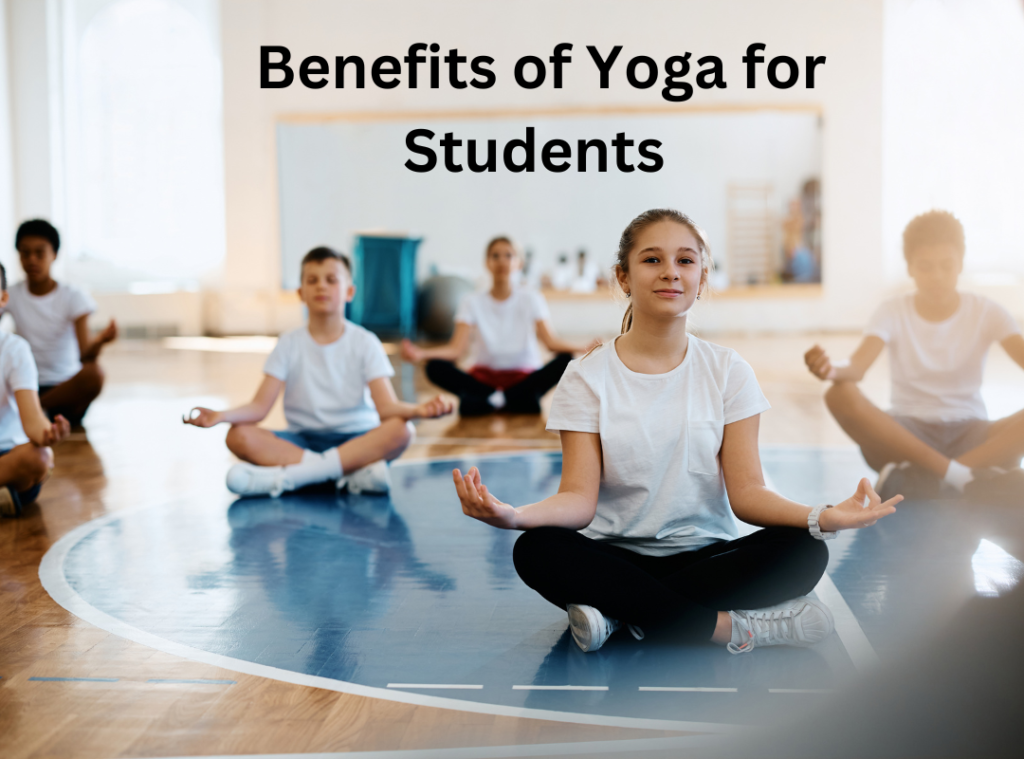
In the current scenario, students face enough pressure where hours are spent staring at classroom walls or within the four corners of houses preparing for exams and with that comes much mental and even physical strain. Yoga for students doesn’t just stop at working out; it is putting everything together- the body, mind, and emotions. An ancient Indian tradition, yoga helps students to improve their concentration, memory, and overall well-being, making it a powerful tool for academic success.
The benefits of yoga for students comprise – enhanced focus, reduced stress, and better posture. All essential for mental clarity and physical well-being. Hence, this has led many educational institutions around the world to include yoga as part of their curricula in recognition of the importance of yoga in education. Such co-curricular participation goes a great deal in fostering among students important traits such as discipline and hardiness, as well as a balanced approach to learning. This blog looks at the importance of yoga in a student’s life, with a particular reference to the positive transformation it can cause to academic and personal lives.
Why is Yoga Important for Students?
Today’s students are juggling academic demands, extracurricular activities, and hours of eye-straining screen time during study sessions. Stress, anxiety, and lack of physical activity are becoming the norm. Here’s where yoga shines.
Yoga’s benefits extend beyond stretching muscles or holding challenging poses. Regular yoga practice nurtures three dimensions of well-being—physical, mental, and emotional.
- Physical relief: Yoga alleviates pains stemming from prolonged sitting, such as backaches and stiff necks. It also builds flexibility and core strength.
- Mental clarity: Practices like meditation and breathing exercises calm the mind, helping students manage academic pressure.
- Emotional stability: Yoga teaches emotional resilience, fostering patience and a positive outlook during tough situations like exams or peer stress.
By fostering awareness and mindfulness, yoga can help students develop essential skills like focus, discipline, and self-regulation—keys to improving academic and personal achievements.
The Benefits of Yoga for Students
The benefits of yoga for students are profound and far-reaching. Here are some of the standout advantages that yoga offers to young learners:
1. Enhances Concentration & Memory
With yoga, students can improve their ability to focus and retain information. The combination of physical movement and mindfulness helps sharpen cognitive functions, directly benefiting academic performance.
2. Reduces Stress & Anxiety
Academic pressure, exams, and peer comparisons can take a toll on students’ mental health. Calming practices like Sukhasana (Easy Pose) and pranayama (breathing exercises) reduce cortisol levels, bringing emotional calm and stability.
3. Boosts Physical Fitness & Posture
Poor posture due to long study hours often leads to chronic pain among students. Poses like Bhujangasana (Cobra Pose) help strengthen the back, prevent spinal issues, and improve overall flexibility.
4. Improves Discipline & Self-Control
Yoga teaches patience and consistency, helping students manage their schedules better. Through mindfulness, they can resist distractions like excessive phone use.
5. Enhances Creativity & Confidence
Yoga opens up avenues for self-expression while building emotional resilience. Students feel more confident tackling challenges, whether it’s a school presentation or a new hobby.
The benefits of yoga for students make it an invaluable addition to their daily routine, preparing them for both academic success and personal growth.
The Importance of Yoga in Education
The importance of yoga in education cannot be overstated. Schools and universities worldwide are incorporating yoga programs into their curriculums, recognizing its many advantages.
Why Integrate Yoga into Education?
- Holistic Development: By focusing on physical and mental well-being, yoga promotes all-round development.
- Improved Learning Outcomes: Students who practice yoga often show better focus, improved memory, and greater academic results.
- Stress Management: Regular yoga practice equips students with tools to manage stress effectively, improving their overall mental health.
Real-Life Examples
- A study published in the Journal of Developmental & Behavioral Pediatrics found that students performing yoga daily were more focused and less stressed.
- Schools in Finland and the U.S. have reported better academic performance and classroom behavior after introducing yoga sessions.
With such overwhelming evidence, it’s clear that yoga can revolutionize education by fostering healthier, happier students.
Best Yoga Poses for Students
Not sure where to start? These simple but powerful yoga poses are perfect for students to include in their daily lives.
- Tadasana (Mountain Pose)
Improves posture, builds stability, and enhances overall body alignment.
- Vrikshasana (Tree Pose)
Boosts balance and concentration—ideal before studying or exams.
- Bhujangasana (Cobra Pose)
Relieves stiffness caused by long hours of sitting and strengthens the back.
- Sukhasana (Easy Pose) & Pranayama (Breathing Exercises)
Reduces stress, calms the mind, and improves breathing patterns.
Start with just 5–10 minutes a day and gradually increase your practice for consistent benefits.
How to Incorporate Yoga into Student Life
Yoga isn’t just about rolling out a mat once a week; it’s about integrating mindful practices into daily life. Here are ways students can start small but stay committed:
1. Create a Daily Routine
Dedicate 15–20 minutes in the morning or evening to yoga. A simple flow of stretches followed by breathing exercises can set a positive tone for the day.
2. Stress-Relief Before Exams
Practice breathing exercises like Anulom Vilom (Alternate Nostril Breathing) to calm nerves before a test. It helps students focus better and approach challenges with a cool head.
3. Family & Peer Encouragement
Parents and teachers play a huge role in promoting yoga. Join your child in practicing yoga at home or encourage classrooms to include short mindfulness breaks.
4. Use Technology
Apps and YouTube channels provide guided yoga sessions tailored for beginners. Students can follow along during breaks or weekends.
The key is consistency—small but steady efforts deliver significant results over time.
Choose Yoga for a Better Tomorrow
The importance of yoga for students goes beyond flexibility or physical fitness. It’s about equipping young minds with tools for focus, productivity, and resilience to face any challenge that comes their way.
Whether a quick stretch before class or dedicated meditation before bedtime, yoga can fit seamlessly into student life. The best part? Its benefits last a lifetime.
Start exploring the benefits of yoga for students today. With a healthier mind and body, every student can unlock their full potential.




